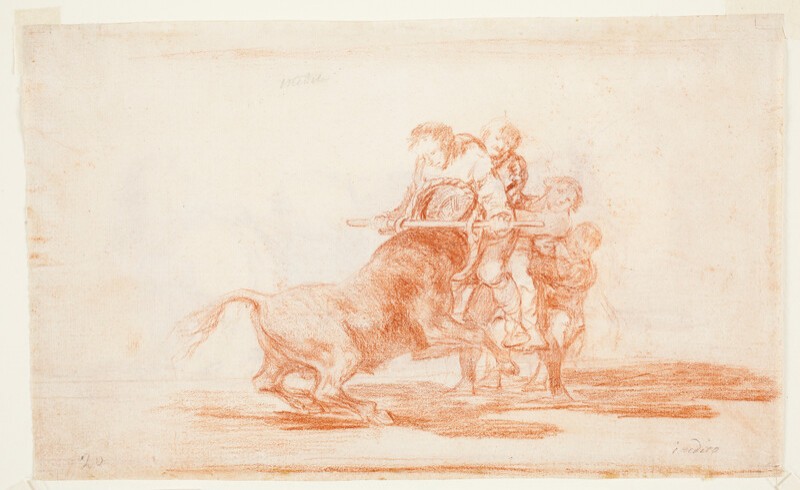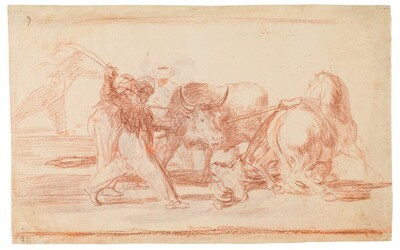- Cronología
- Ca. 1814 - 1816
- Ubicación
- The Prado National Museum. Madrid, Madrid, Spain
- Dimensiones
- 176 x 288 mm
- Técnica y soporte
- Sanguine on laid paper
- Reconocimiento de la autoría de Goya
- Documented work
- Titular
- El Prado National Museum
- Ficha: realización/revisión
- 03 Oct 2021 / 22 Jun 2023
- Inventario
- (D4357 r.)
- Otros títulos:
-
unpublished (in pencil, top left)
unpublished (in pencil, bottom right)
20 (in pencil, bottom left corner)
12 (in red pencil, reverse side, bottom)
See How the ancient Spaniards hunted bulls on horseback in the countryside.
This preparatory drawing passed by inheritance in 1828 to Javier Goya, the painter's son, and in 1854 to Mariano Goya y Goicoechea, the artist's grandson. It was subsequently owned by Valentín Carderera (ca. 1861) and Mariano Carderera (1880). In 1886 it was acquired from Mariano Carderera, along with many other drawings by Goya, including almost all the preparatory studies for the Bullfight, by the Directorate General of Public Instruction, and was assigned to the Prado Museum, where it entered on 12 November 1886.
See How the ancient Spaniards hunted bulls on horseback in the countryside.
Preparatory drawing for a print of bullfighting which was never engraved, or at least of which neither the plate nor any proof of condition has survived. It is on the reverse of another preparatory drawing of the series: The Moors established in Spain, dispensing with the superstitions of their Alcoran, adopted this hunting and art, and they throw a bull in the field.
The scene, of great plastic dynamism, shows us a very original and curious type of popular bullfighting that was and still is practised in some villages along the banks of the Ebro river in Zaragoza, such as El Burgo and Fuentes de Ebro, in which a group of young men standing in line face the powerful onslaught of a steer or bull, protected only by a basket with a stick pierced through the handles, known as a roscadero. As we can see, the memory of Aragonese bullfighting traditions lived on in Goya's mind.
The scene, of great compositional simplicity but with great expressive and plastic power, shows the charge of a bull or steer that lunges from the left at a group of four young men in a row, protected by a basket held by the first of them. Goya perfectly depicts the movement generated by the bull's strong lunge as it lifts the bull's front legs and the first two runners, who are lifted into the air.
-
Madrid2002
-
MadridMuseo del Prado1954cat. 194
-
OxfordBruno Cassirer1964vol. II, 1964, p. 362, cat. 247b
-
Vie et ouvre de Francisco de GoyaParísOffice du livre1970p. 281, cat. 1243
-
Dibujos de Goya, 2 volsBarcelonaNoguer1975pp. 428-429, cat. 289
-
MadridSilex1980cat. 54
-
Goya y Aragón. Familia, amistades y encargos artísticoscol. Col. Mariano de Pano y RuataZaragozaCaja de Ahorros de la Inmaculada de Aragón1995pp. 227-228
-
MadridMuseo Nacional del Prado2001p. 111

